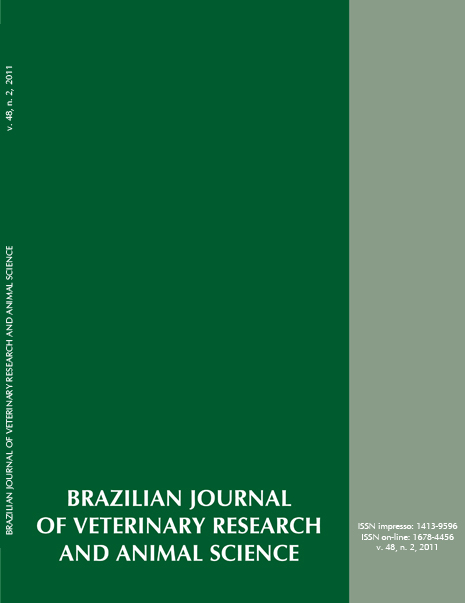Clinical and laboratorial changes in horses adapted to diet with high levels of concentrated and submitted to dietetic starch overload
DOI:
https://doi.org/10.11606/S1413-95962011000200003Keywords:
Equine, Carbohydrate, Overload, Clinical, Clinical PathologyAbstract
This work was carried out to evaluate the effect of dietetic starch overload in horses adapted to diets with high level of concentrated. Six crossbreed mature horses were previously adapted to diet composed by coast cross hay and concentrate in a 60:40 proportion and later submitted to gastric infusion of 17.6 g starch/kg body weight. The horses were evaluated by clinical and laboratorial examination until 36-hour after overload. One horse died 32 hours after overload, presenting clinical signs of endotoxemia and laminitis.No differences (P > 0.05) were observed in heart and respiratory rate, rectal temperature, capillary refill time and hoof temperature of horses. There was a tendency to increase intestinal mobility following by fluidity of faeces. Increase (P < 0.05) in packed cell volume and total plasma protein were observed 24 hours after overload when compared to baseline, from 26.7 to 32.0% and 7.1 to 8.1 g/dL, respectively. Neutrophils increased (P < 0.05) during the evaluation period, with values varying of 0.1 to 0.7 x 10³/µL before overload and 24 hours after, respectively, while the eosinophils decreased. The plasma lactate concentration was slight increased with difference (p < 0.05) before, 20 and 28 hours after overload, with values of 0.7, 1.0 and 1.2 mmol/L, respectively. It was concluded that horses consuming diets with high levels of concentrated and submitted to dietetic starch overload had clinical and laboratory changes moderate, however, severe cases, followed by death may occur due to individual variation.Downloads
Download data is not yet available.
Downloads
Published
2011-04-01
Issue
Section
UNDEFINIED
License
The journal content is authorized under the Creative Commons BY-NC-SA license (summary of the license: https://
How to Cite
1.
Santos TM dos, Almeida FQ de, Pires MS, Santiago JM, Roier ECR, Guedes Júnior DS, et al. Clinical and laboratorial changes in horses adapted to diet with high levels of concentrated and submitted to dietetic starch overload. Braz. J. Vet. Res. Anim. Sci. [Internet]. 2011 Apr. 1 [cited 2026 Jan. 2];48(2):116-22. Available from: https://revistas.usp.br/bjvras/article/view/34362





